Lesson 4Color Mixtures
Let’s see what color-mixing has to do with ratios.
Learning Targets:
- I can explain the meaning of equivalent ratios using a color mixture as an example.
- I can use a diagram to represent a single batch, a double batch, and a triple batch of a color mixture.
- I know what it means to double or triple a color mixture.
4.1 Number Talk: Adjusting a Factor
Find the value of each product mentally.
4.2 Turning Green
-
In the left cylinder, mix 5 ml of blue and 15 ml of yellow. This is a single batch of green.
-
Suppose you have one batch of green but want to make more. Which of the following would produce the same shade of green?
If you're unsure, try creating the mixture in the right cylinder. Start with the amounts in a single batch (5 ml of blue and 15 ml of yellow) and . . .
- add 20 ml of blue and 20 ml of yellow
- double the amount of blue and the amount of yellow
- triple the amount of blue and the amount of yellow
- mix a single batch with a double batch
- double the amount of blue and triple the amount of yellow
-
For one of the mixtures that produces the same shade, write down the number of ml of blue and yellow used in the mixture.
-
For the same mixture that produces the same shade, draw a diagram of the mixture. Make sure your diagram shows the number of milliliters of blue, yellow, and the number of batches.
-
Someone was trying to make the same shade as the original single batch, but started by adding 20 ml of blue and 20 ml of yellow. How can they add more but still create the same shade of green?
-
Invent a recipe for a bluer shade of green. Write down the amounts of yellow and blue that you used, and draw a diagram. Explain how you know it will be bluer than the original single batch of green before testing it out.
Are you ready for more?
Someone has made a shade of green by using 17 ml of blue and 13 ml of yellow. They are sure it cannot be turned into the original shade of green by adding more blue or yellow. Either explain how more can be added to create the original green shade, or explain why this is impossible.
4.3 Perfect Purple Water
The recipe for Perfect Purple Water says, “Mix 8 ml of blue water with 3 ml of red water.”
Jada mixes 24 ml of blue water with 9 ml of red water. Andre mixes 16 ml of blue water with 9 ml of red water.
- Which person will get a color mixture that is the same shade as Perfect Purple Water? Explain or show your reasoning.
-
Find another combination of blue water and red water that will also result in the same shade as Perfect Purple Water. Explain or show your reasoning.
Lesson 4 Summary
When mixing colors, doubling or tripling the amount of each color will create the same shade of the mixed color. In fact, you can always multiply the amount of each color by the same number to create a different amount of the same mixed color.
For example, a batch of dark orange paint uses 4 ml of red paint and 2 ml of yellow paint.
- To make two batches of dark orange paint, we can mix 8 ml of red paint with 4 ml of yellow paint.
- To make three batches of dark orange paint, we can mix 12 ml of red paint with 6 ml of yellow paint.
Here is a diagram that represents 1, 2, and 3 batches of this recipe.
We say that the ratios , , and are equivalent because they describe the same color mixture in different numbers of batches, and they make the same shade of orange.
Lesson 4 Practice Problems
Here is a diagram showing a mixture of red paint and green paint needed for 1 batch of a particular shade of brown.
Add to the diagram so that it shows 3 batches of the same shade of brown paint.
Diego makes green paint by mixing 10 tablespoons of yellow paint and 2 tablespoons of blue paint. Which of these mixtures produce the same shade of green paint as Diego’s mixture? Select all that apply.
- For every 5 tablespoons of blue paint, mix in 1 tablespoon of yellow paint.
- Mix tablespoons of blue paint and yellow paint in the ratio .
- Mix tablespoons of yellow paint and blue paint in the ratio 15 to 3.
- Mix 11 tablespoons of yellow paint and 3 tablespoons of blue paint.
To make 1 batch of sky blue paint, Clare mixes 2 cups of blue paint with 1 gallon of white paint.
- Explain how Clare can make 2 batches of sky blue paint.
- Explain how to make a mixture that is a darker shade of blue than the sky blue.
- Explain how to make a mixture that is a lighter shade of blue than the sky blue.
A smoothie recipe calls for 3 cups of milk, 2 frozen bananas and 1 tablespoon of chocolate syrup.
- Create a diagram to represent the quantities of each ingredient in the recipe.
- Write 3 different sentences that use a ratio to describe the recipe.
Write the missing number under each tick mark on the number line.

Find the area of the parallelogram. Show your reasoning.

Complete each equation with a number that makes it true.
(As long as does not equal 0.)